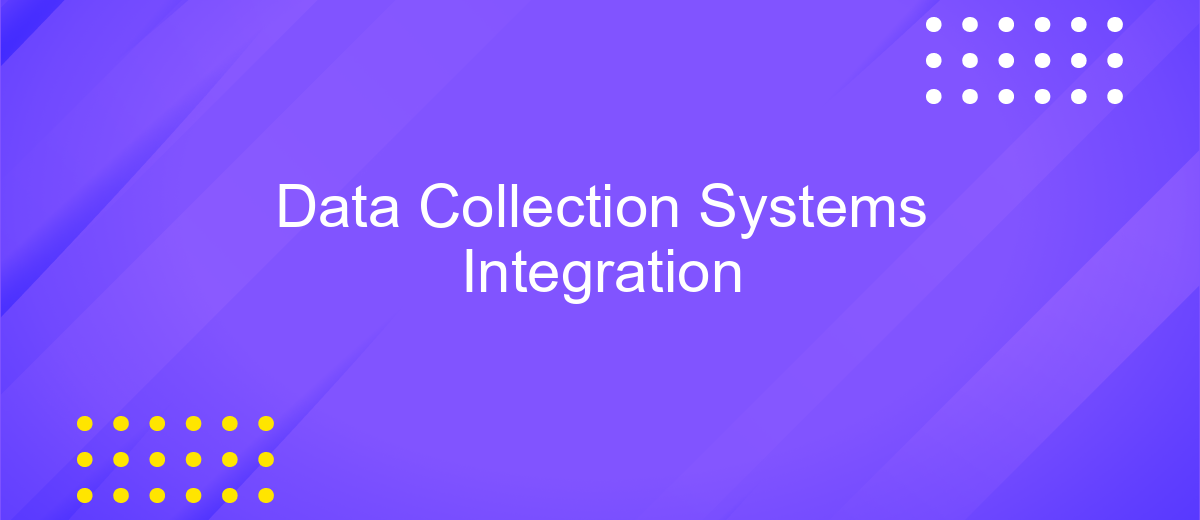Data Collection Systems Integration
In today's data-driven world, the seamless integration of data collection systems is crucial for businesses to harness actionable insights and drive informed decision-making. This article explores the importance of integrating various data collection systems, highlighting the benefits, challenges, and best practices to ensure a cohesive and efficient data management strategy. Discover how to unlock the full potential of your data assets through effective integration.
Introduction
In today's data-driven world, integrating data collection systems is crucial for organizations aiming to harness the full potential of their data. Effective integration enables seamless data flow between various sources, improving decision-making processes and operational efficiency. The complexity of modern data environments necessitates robust strategies for integrating disparate systems, ensuring data consistency, accuracy, and accessibility.
- Enhanced data accuracy and consistency
- Improved decision-making capabilities
- Streamlined operations and reduced redundancies
- Increased data accessibility and usability
- Cost savings through optimized resource utilization
Successful data collection systems integration requires a comprehensive approach that encompasses technical, organizational, and strategic considerations. By leveraging advanced integration technologies and best practices, organizations can unlock the true value of their data assets, driving innovation and competitive advantage. This section explores the key aspects of data collection systems integration, offering insights into the challenges and solutions that define this critical process.
Data Collection Systems

Data collection systems are essential for gathering, processing, and analyzing data from various sources. These systems can range from simple manual entry methods to advanced automated solutions that integrate with multiple data sources. The primary goal of data collection systems is to ensure accurate and efficient data capture, which can then be used for analysis, decision-making, and reporting. Modern data collection systems often leverage cloud technologies, IoT devices, and machine learning algorithms to enhance data accuracy and provide real-time insights.
Integrating data collection systems can be a complex task, requiring seamless connectivity between disparate systems and platforms. Services like ApiX-Drive simplify this process by offering a user-friendly interface for setting up integrations without the need for extensive coding knowledge. ApiX-Drive supports a wide range of applications and can automate data transfer between systems, ensuring that data is consistently updated and accessible. By leveraging such integration services, organizations can streamline their data collection processes, reduce manual errors, and ensure real-time data availability for better decision-making.
Integration Challenges

Integrating data collection systems presents several challenges that organizations must navigate to ensure seamless data flow and accuracy. These challenges often stem from the diversity of data sources, the complexity of data formats, and the need for real-time data processing. Addressing these issues is crucial for maintaining data integrity and achieving reliable insights.
1. Data Heterogeneity: Different systems often use varied data formats, making it difficult to standardize and integrate data efficiently.
2. Scalability Issues: As the volume of data grows, systems must be able to scale without compromising performance.
3. Real-time Processing: Ensuring that data is processed and available in real-time can be technically demanding.
4. Security Concerns: Integrating multiple systems increases the risk of data breaches and requires robust security measures.
5. Compatibility Problems: Legacy systems may not easily integrate with newer technologies, requiring significant modifications.
Overcoming these integration challenges necessitates a strategic approach that includes adopting advanced integration tools, implementing stringent security protocols, and ensuring continuous monitoring and optimization. By addressing these challenges proactively, organizations can enhance their data collection capabilities and leverage data-driven decision-making effectively.
Integration Strategies

Integrating data collection systems requires a well-thought-out strategy to ensure seamless data flow and interoperability. The first step involves assessing the existing infrastructure to identify compatibility issues and potential integration points. This assessment helps in understanding the scope and scale of integration needed.
Once the assessment is complete, the next step is to choose the right integration method. Common methods include point-to-point integration, middleware solutions, and API-based integration. Each method has its pros and cons, depending on the complexity and requirements of the systems involved.
- Point-to-point integration: Directly connects two systems for straightforward data exchange.
- Middleware solutions: Use intermediary software to facilitate communication between multiple systems.
- API-based integration: Utilizes application programming interfaces for flexible and scalable data exchange.
After selecting the appropriate method, it is essential to implement robust data governance policies to ensure data quality and security. Continuous monitoring and regular updates are crucial for maintaining the efficiency and reliability of the integrated systems. This approach not only enhances operational efficiency but also supports informed decision-making.
- Automate the work of an online store or landing
- Empower through integration
- Don't spend money on programmers and integrators
- Save time by automating routine tasks
Benefits of Integration
Integrating data collection systems offers numerous benefits, starting with enhanced efficiency. By consolidating data from multiple sources into a unified system, organizations can streamline their workflows and reduce the time spent on manual data entry. This integration minimizes errors and ensures that all data is accurate and up-to-date, facilitating better decision-making processes. Moreover, it allows for real-time data access, providing stakeholders with immediate insights and fostering a more agile response to changing conditions.
Another significant advantage is the improved data analytics capabilities. When data is integrated, it becomes easier to perform comprehensive analyses, uncovering trends and patterns that might be missed when data is siloed. Tools like ApiX-Drive can simplify the integration process by connecting various applications and automating data transfer, making it easier for organizations to implement and maintain their data collection systems. This not only saves time but also reduces the complexity of managing multiple data sources, ultimately leading to more informed strategic planning and operational efficiency.
FAQ
What is Data Collection Systems Integration?
Why is it important to integrate data collection systems?
How can I integrate different data collection systems?
What are the challenges in integrating data collection systems?
Can I automate the integration of data collection systems?
Do you want to achieve your goals in business, career and life faster and better? Do it with ApiX-Drive – a tool that will remove a significant part of the routine from workflows and free up additional time to achieve your goals. Test the capabilities of Apix-Drive for free – see for yourself the effectiveness of the tool.


